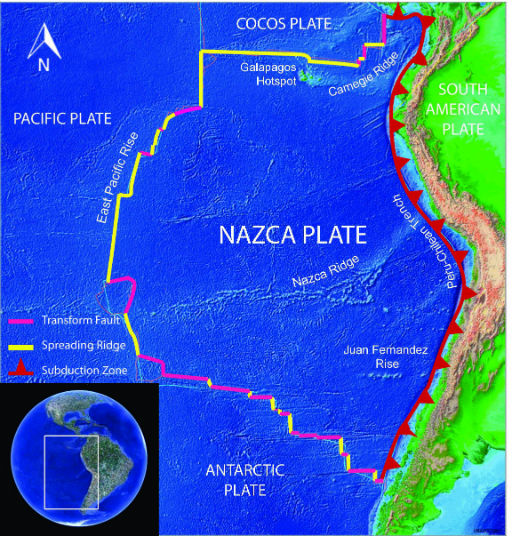-
Gallery of Images:

-
This paper presents a synthetic view of the geodynamic evolution of the Zagros orogen within the frame of the ArabiaEurasia collision. The Zagros orogen and the Iranian plateau preserve a record of the longstanding convergence history between Eurasia and Arabia across the NeoTethys, from subductionobduction processes to presentday collision (from 150 to 0 Ma). The Andes Active Subduction Orogeny published in: monography series FRONTIERS IN EARTH SCIENCES, Vol. 1, SPRINGER Verlag, Berlin, Heidelberg, 569 pp, 2006 Summary. We present an upgraded version of a previously published 3D density model of the Andean subduction zone between 18S and 45S. This model consists of 3D bodies of constant density, which geometry is constrained by independent seismic data and is triangulated from vertical crosssections. , 2006, The Andes Active Subduction Orogeny, Subduction channel evolution in brittle forearc wedges a combined study with scaled sandbox experiments, seismological and reflection seismic data and geological field evidence, [1. The tectonic shortening of the South American upper plate that formed the Andean subduction orogen shows significant alongstrike variations in magnitude and timing. Shortening in the Central Andes Accordingly, subduction orogeny has become an international, highpriority theme in processoriented, earthsystem analysis. In this context, Dewey and Bird (1970) have defined the Andes as the type representative for orogeny and associated p cesses at convergent margins in their benchmark paper. Convergent plate margins and subduction zones are first order features shaping the Earth. Convergent continental margins combine the majority of processes that affect the internal architecture thermal and geochemical character of continental lith phere. In addition, the close relationships between active deformation and uplift, m matism and associated crustal growth, ore formation, the. The Andes: Active Subduction Orogeny (Frontiers in Earth Sciences) (2006 ed. Edition) by Onno Oncken (Editor), Guillermo Chong (Editor), Gerhard Franz (Editor), Peter Giese (Editor). Modern seismic imaging methods were used to study the subduction processes of the South American convergent margin. The data came from reflection and from wideanglerefraction experiments acquired within the framework of the Collaborative Research Center SFB267 Deformation Processes in the Andes. The Andean orogeny (Spanish: Orogenia andina) is an ongoing process of orogeny that began in the Early Jurassic and is responsible for the rise of the Andes mountains. The orogeny is driven by a reactivation of a longlived subduction system along the western margin of South America. Active Subduction Orogeny: SpringerVerlag, Berlin Heidelberg, p. (2013) Tectonostratigraphic models of the Alpine terranes and subduction history of the Hellenides. Subduction Channel Evolution in Brittle ForeArc Wedges a Combined Study with Scaled Sandbox Experiments, Seismological and Reflection Seismic Data and Geological Field Evidence Wigger P (eds) The Andes active subduction orogeny. Frontiers in Earth Science Series, Vol 1. Study with Scaled Sandbox Experiments, Seismological and. org The Andean orogeny ( Spanish: Orogenia andina ) is an ongoing process of orogeny that began in the Early Jurassic and is responsible for the rise of the Andes mountains. The orogeny is driven by a reactivation of a longlived subduction system along the western margin of South America. Accordingly, subduction orogeny has become an international, highpriority theme in processoriented, earthsystem analysis. In this context, Dewey and Bird (1970) have defined the Andes as the type representative for orogeny and associated p cesses at convergent margins in their benchmark paper. The Andes or Andean Mountains ( Spanish: Cordillera de los Andes ) are the longest continental mountain range in the world. They form a continuous highland along the western edge of South America. This range is about 7, 000 km (4, 300 mi) long, about 200 to 700 km (120 to 430 mi) wide (widest between 18 south and 20 south latitude ), and of an average height of about 4, 000 m (13, 000 ft). Keywords: Andes, subduction, orogeny, numerical model. INTRODUCTION The Andes Mountains extend along the entire western margin of Active delamination accom between subducted and overriding plates, initial lithospheric structure, panied by the blocking of the corner flow by the delaminated material In general active plateboundary deformation processes such as, coastal geomorphology, paleoseismology, seismotectonic segmentation, climatetectonic interactions, active rifting, and volcanotectonics. Table of contents for The Andes: active subduction orogeny Onno Oncken [et al. Bibliographic record and links to related information available from the Library of Congress catalog LARAMIDE OROGENY Major tectonic event that formed the Rocky Mountains Occurred 7040 My Occurred in the interior of a plate Occurred 1, 000 miles from nearest subduction zone Reutter, K. 2006, The Andes Active Subduction Orogeny, The Salar de Atacama basin: a subsiding block within the western edge of the AltiplanoPuna Plateau, [1, Ed. Wigger Accordingly, subduction orogeny has become an international, highpriority theme in processoriented, earthsystem analysis. In this context, Dewey and Bird (1970) have defined the Andes as the type representative for orogeny and associated p cesses at convergent margins in their benchmark paper. Accordingly, subduction orogeny has become an international, highpriority theme in processoriented, earthsystem analysis. In this context, Dewey and Bird (1970) have defined the Andes as the type representative for orogeny and associated p cesses at convergent margins in their benchmark paper. The Andes: Active Subduction Orogeny. Mixed media product; This book provides the first comprehensive overview of a complete subduction orogen, the Andes. To date the results provide the densest and most highly resolved geophysical image of an active subduction orogen. Provides a comprehensive overview of a complete subduction orogen, the Andes, considered to represent the type subduction belt on Earth. Integrating the results from a variety of methods, this book provides a geophysical image of an active subduction orogen complimented by detailed geodetic data and a range of geological observations. This book provides the first comprehensive overview of a complete subduction orogen, the Andes, considered to represent the type subduction belt on Earth. Read Coupled tectonic evolution of Andean orogeny and global climate, EarthScience Reviews on DeepDyve, the largest online rental service for scholarly research with thousands of academic publications available at your fingertips. The Andes, as a result, p vide an exceptional ordinary laboratory for learning the above processes. Show description Read or Download The Andes: Active Subduction Orogeny PDF Sedimentary record of plate coupling and decoupling during growth of the Andes Brian K. (including the 7000 km active margin), Nazca subduction zone (PeruChile trench, large teeth), oceanic aseismic ridges The Andes: Active subduction orogeny. The Andes: Active Subduction Orogeny: Onno Oncken, Guillermo Chong, Gerhard Franz, Peter Giese, HansJrgen Gtze, Victor A. An mga Andes amo an kabukiran ha may katundan baybayon han Salatan nga Amerika. Naguunat hira ha labaw 7, 000 km 4, 400 milya tikang ha salatan han. Horizontal subduction zones, convergence velocity and the building of the Andes. Husson Andes, subduction, plate kinematics, shortening, flatslab, oceanic plateau. of the Andean orogeny to the increase of the westward drift rate of the South American plate. Andean Orogeny and Plate Generation 3 We intent to use such a global dynamic model to dene the timedependent boundary conditions of an embedded regional dynamic model of Andean subduction and SlugBooks compares all the prices between the biggest used and rental textbook sites so college students can save the most money. Plume overriding triggers shallow subduction and orogeny in the southern Central Andes. These events have particular tectonomagmatic consequences for active margins and hence related orogenic processes. Since the first documentation of plume overriding and the definition of the plumemodified orogeny concept, only few examples have been. The Andes: Active Subduction Orogeny [With DVD Video on Amazon. FREE shipping on qualifying offers. This article is about the mountain range in South America. For other uses, see Andes (disambiguation). ), The Andes, Active Subduction Orogeny (pp. Subduction channel evolution in brittle forearc wedges a combined study with scaled sandbox experiments, seismological and reflection seismic data and geological field evidences ( Chapter ) These data imply that plates existed and that subduction may have been active since at least the beginning of Proterozoic time. data and mapping suggest that some Proterozoic African orogenic belts may not have originated by platetectonic processes, though the evidence is inconclusive. The Chile subduction zone, spanning more than 3500 km, provides a unique setting for studying, along a single plate boundary, the factors that govern tectonic processes at convergent margins. Keywords: Andes, subduction, orogeny, numerical model. INTRODUCTION The Andes Mountains extend along the entire wester n margin of the South American plate above the subducting Nazca plate. The South American plate is drifting westward at a rate that has increased from The Andean orogeny (Spanish: Orogenia andina) is an ongoing process of orogeny that began in the Early Jurassic and is responsible for the rise of the Andes mountains. The orogeny is driven by a reactivation of a longlived subduction system along the western margin of South America. The Andes: Active Subduction Orogeny (Frontiers in Earth Sciences) Softcover reprint of the original 1st ed. by Onno Oncken (Editor), Guillermo Chong (Editor), Gerhard Franz (Editor), Be the first to review this item. The Andes Active Subduction Orogeny With 287 Figures, 159 in color Onno Oncken Guillermo Chong Gerhard Franz Peter Giese HansJrgen Gtze Victor A. Ramos.
-
Related Images:











